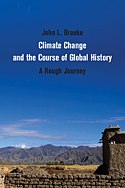 The title in the Kindle Store was irresistible: Climate Change and the Course of Global History: A Rough Journey. American historian John L Brooke is the author, and the book is notable for its attempt to integrate climate science with the study of human history. In his acknowledgements the author brackets climate scientists with historians and archaeologists in the long list of people with whom he has corresponded and from whom he has received data and an understanding of scientific culture.
The title in the Kindle Store was irresistible: Climate Change and the Course of Global History: A Rough Journey. American historian John L Brooke is the author, and the book is notable for its attempt to integrate climate science with the study of human history. In his acknowledgements the author brackets climate scientists with historians and archaeologists in the long list of people with whom he has corresponded and from whom he has received data and an understanding of scientific culture.
The scope of the book is as wide as human emergence in the evolutionary process, and before. It’s not my purpose to track through the long story the author has to tell or to follow the intricacies of the climate shifts he refers to. The book demands and rewards patient reading in these respects. But I offer a few comments arising from my reading of the book.
An historian making the effort to understand climate science as thoroughly as Brooke does seems to me in itself worth remarking. Often I could have been reading one of the many books by scientists or science writers that I’ve reviewed over past years on Hot Topic. The culture gap between the sciences and the humanities that C P Snow’s famous 1959 lecture lamented was certainly not evident in Brooke’s history. Five years ago I reported the plea of biographer Richard Holmes at the Hay Festival that we reject the notion of two cultures and accept the duty to understand the scientific discoveries of the modern age, a duty of crucial importance in the face of global warming. Brooke has clearly accepted that duty, though I fear many educated in the humanities continue to excuse themselves from it.
Continue reading “Climate Change and the Course of Global History”

 The NZ Emissions Trading Scheme has failed and should be replaced by a carbon tax, Green Party co-leader Russel Norman
The NZ Emissions Trading Scheme has failed and should be replaced by a carbon tax, Green Party co-leader Russel Norman  Analysis of a report on sea level rise —
Analysis of a report on sea level rise —  In which I pull together the strands of the recent bad news from Antarctica and Greenland, and lament the loss of the coastline we all grew up with — no longer a theoretical possibility but a long term certainty. Check out
In which I pull together the strands of the recent bad news from Antarctica and Greenland, and lament the loss of the coastline we all grew up with — no longer a theoretical possibility but a long term certainty. Check out